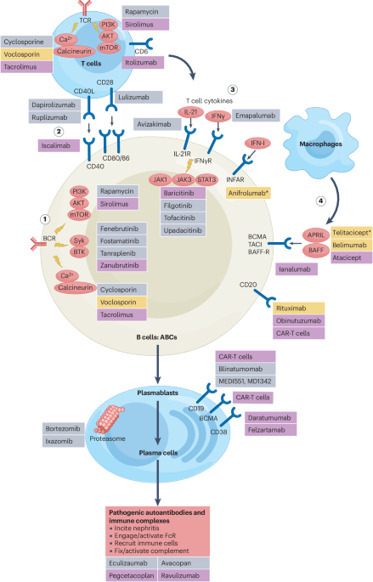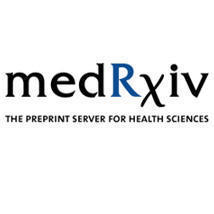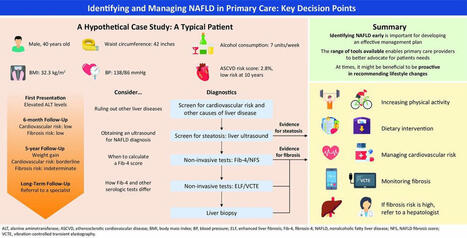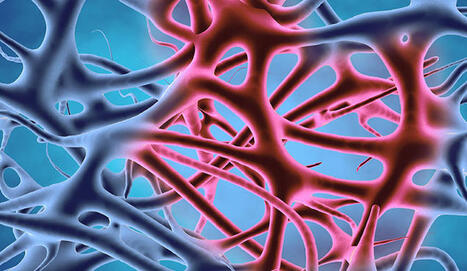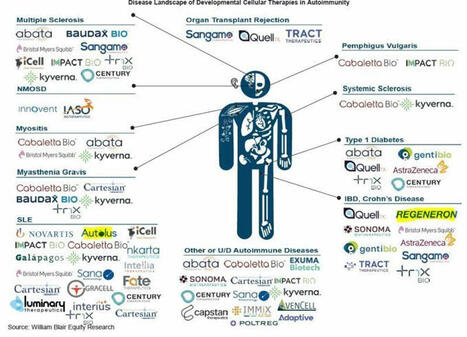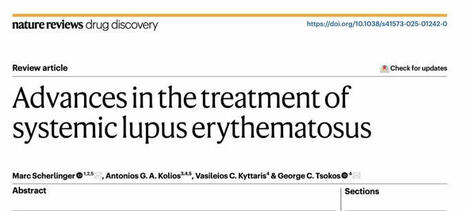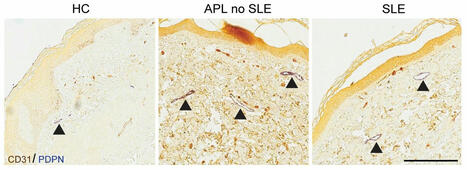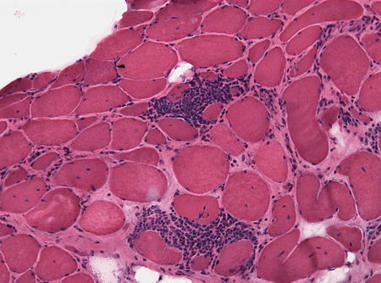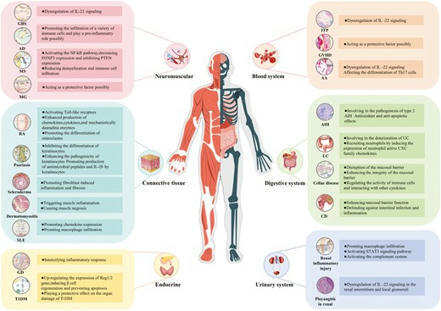Abstract Between 50% and 86% of patients with autoimmune hepatitis (AIH) relapse after immunosuppression withdrawal; long‐term immunosuppression is associated with increased risk of neoplasias and infections. Chloroquine diphosphate (CQ) is an immunomodulatory drug that reduces the risk of flares in rheumatologic diseases. Our aims were to investigate the efficacy and safety of CQ for maintenance of biochemical remission of AIH in a double‐blind randomized trial and to define a subgroup that obtained a greater benefit from its use. A total of 61 patients with AIH in histologic remission (90.1% AIH type 1 [AIH‐1]) were randomized to receive CQ 250 mg/day or placebo for 36 months. Of the 61 patients, 31 received CQ and 30 placebo. At baseline, clinical, laboratory, histologic findings, and human leukocyte antigen (HLA) profile were similar between the two groups. Relapse‐free survival was significantly higher in the CQ group compared to the placebo group (59.3% and 19.9%, respectively P = 0.039). For those patients completing 3‐year treatment, relapse rates were 41.6% and 0% after CQ and placebo withdrawal, respectively. Factors associated with a higher risk of relapse in multiple Cox regression were placebo use (hazard ratio, 2.4; 95% confidence interval [CI], 1.055.5; P = 0.039) and anti‐soluble liver antigen/liver‐pancreas (anti‐SLA/LP) seropositivity (hazard ratio, 5.4; 95% CI, 1.91‐15.3; P = 0.002). Although it was not possible to define a subgroup that obtained a greater benefit from CQ according to anti‐SLA/LP reactivity or HLA profile, 100% of patients who were anti‐SLA/LP‐positive (+) relapsed with placebo compared to 50% with CQ (P = 0.055). In the CQ group, 54.8% had side effects and 19.3% interrupted the drug regimen. Conclusion: CQ safely reduced the risk of relapse of AIH, but it was not possible to define a subgroup that obtained a greater benefit with CQ use, probably because of sample size. Abbreviations – negative + positive AIH autoimmune hepatitis AIH‐1/2 AIH type 1/2 ALT alanine aminotransferase anti‐LKM1 anti‐liver/kidney microsomal antibody type 1 anti‐SLA/LP anti‐soluble liver antigen/liver‐pancreas CI confidence interval CQ chloroquine diphosphate HLA human leukocyte antigen HLA‐DQ human leukocyte antigen isotype DQ HLA‐DR human leukocyte antigen isotype DR IAIHG International Autoimmune Hepatitis Group IgG immunoglobulin G The goal of treatment in autoimmune hepatitis (AIH) is to achieve normalization of aminotransferase and immunoglobulin G (IgG) levels with absent or minimal histologic activity to prevent disease progression. A sustained remission of treatment after its withdrawal is the most desirable endpoint. However, most patients relapse within the first year and need reintroduction of treatment, and only approximately 20% achieve this goal.1-3 Patients who present multiple relapses evolve more frequently for liver cirrhosis, death due to liver disease, and the need for liver transplantation than those who remain in sustained remission.4 A significant advance in the treatment of AIH would be the identification of drugs with a good safety profile and few side effects that would allow the maintenance of AIH remission after withdrawal of the immunosuppressive treatment. Antimalarial drugs have been prescribed for almost 400 years and are used in the treatment of systemic lupus erythematosus with benefits in symptomatic control, general and disease‐free survival, and reduction of severity of disease exacerbations.5, 6 Chloroquine diphosphate (CQ) has multiple mechanisms of action in immune response; this could justify its use in the treatment of AIH. CQ 250 mg/day was used for maintenance of disease remission after immunosuppression withdrawal in a preliminary pilot study with 14 patients in histologic remission; in that study, the CQ‐treated group had a 6.49‐fold lower risk of disease relapse.7 In 2 patients who were anti‐soluble liver antigen/liver‐pancreas (anti‐SLA/LP)(+) and who relapsed after CQ withdrawal, its reintroduction as monotherapy (on request) resulted in normalization of aminotransferases and, in one case, histologic remission. The aims of this study were to evaluate whether CQ is safe and effective in preventing relapse of AIH in patients with histologic remission of the disease after immunosuppression withdrawal and whether there is a specific patient profile in which it could be more beneficial. Participants and Methods Trial Design and Participants This was an interventional, single‐center, randomized, double‐blind, controlled, parallel‐group trial of 36 months of CQ versus placebo in patients with AIH in histologic remission. The authors designed the protocol, monitored patients, acquired and maintained the data, and performed statistical analysis. The protocol was approved by the local ethics committees and registered in the ClinicalTrials.gov database (NCT01980745). All subjects signed a written informed consent before enrollment, and the study was performed according to good clinical practice and the Declaration of Helsinki. Patients 18 to 70 years of age with a probable/definite diagnosis of AIH according to International Autoimmune Hepatitis Group (IAIHG) criteria8 who had biochemical and histologic remission after immunosuppressive therapy were eligible for enrollment in this study. Exclusion criteria were overlapping syndromes with primary biliary cholangitis and primary sclerosing cholangitis, decompensated liver cirrhosis (presence of ascites, hepatic encephalopathy, spontaneous bacterial peritonitis, acute variceal bleeding, or Child‐Turcotte‐Pugh B and C classification), enrollment in a previous study with antimalarial drugs, and pregnancy. Interventions All patients received initial treatment with azathioprine and prednisone, most of them in doses of 50 mg/day and 30 mg/day, respectively. There were monthly reductions in prednisone dose and increases in dose of azathioprine if necessary (up to 2 mg/kg/day if tolerated) in order to maintain the levels of aminotransferases within the normal reference range with the lowest dose possible. Doses of prednisone ranged from 5 to 15 mg/day and azathioprine from 50 to 150 mg/day during maintenance treatment. After normalization of hepatic enzymes with stable doses of the drugs, there were no additional adjustments in the doses (except in the cases of adverse effects that justified some modification) until the liver biopsy was performed to evaluate histologic remission, which never occurred before 18 months of normal aminotransferases and 2 years of treatment. Histologic remission was defined as absence or presence of minimal interface hepatitis (hepatitis activity index <4) according to the IAIHG definition.2 The histologic evaluation was performed by experienced liver pathologists according to the Brazilian Society of Pathology.9 Following confirmation of histologic remission, patients were randomized to receive either a fixed dose of CQ (250 mg/day, drug A) or placebo (drug B). CQ was chosen because it was the only formulation available for dispensing by the public health system. In the first month after enrollment, patients received CQ or placebo in addition to the immunosuppressive regimen that induced histologic remission; this was azathioprine and prednisone in all cases. During the second month, azathioprine was discontinued immediately, with weekly weaning of 2.5 mg of the prednisone maintenance dose. Subsequently, the patients remained on drug A or drug B for up to 36 months, disease relapse, significant side effects, pregnancy, or willing withdrawal from the study. Follow‐up was for at least 1 year after the end of the protocol. Primary Outcomes The primary outcome was the maintenance of biochemical response following immunosuppression withdrawal, which was defined as aminotransferase levels within the normal reference range. Relapse of AIH was defined as elevation of aminotransferase levels above twice the normal upper reference value in at least two different measurements taken within a 15‐day interval during which there was no tendency for liver enzymes to fall or stabilize. Routine blood tests and clinical evaluation were performed monthly during the first 6 months of the study, every 2 months or earlier if necessary until the end of the first year, and every 3 months until the end of the study. Secondary Outcomes Secondary outcomes were to determine whether there was a specific group of patients who would benefit most from the ingestion of CQ and to assess the safety profile of the drug. Autoantibody Testing Anti‐nuclear, anti‐smooth muscle, anti‐liver/kidney microsomal antibody type 1 (anti‐LKM1), anti‐liver cytosol type 1, and anti‐mitochondrial antibodies were detected by indirect immunofluorescence; performed on frozen unfixed rodent substrate that included kidney, liver, and stomach; and were considered positive if the titers were greater than or equal to 1:40 according to IAIHG diagnosis criteria.10 The fluorescent patterns of anti‐nuclear and anti‐microfilament antibodies were detected by indirect immunofluorescence on human epithelial type 2 (HEp2) cells and human fibroblasts. Anti‐SLA/LP antibodies were detected by enzyme‐linked immunosorbent assay using the commercial kits Quanta Lite SLA (Inova Diagnostics Inc., San Diego, CA) and/or anti‐SLA/LP IgG (EUROIMMUN, Luebeck, Germany), according to the manufacturer’s instructions, which consider positive values as ≥25 units and ≥1, respectively. Human Leukocyte Antigen Typing Human leukocyte antigen (HLA) typing was performed with DNA samples previously extracted using the dodecyltrimethylammonium bromide (DTAB)/cetyltrimethylammonium bromide (CTAB) technique and stored at −20°C. For the amplification reaction of the HLA isotype DR (HLA‐DR) and HLA isotype DQ (HLA‐DQ) genes, specific primers were used to test the polymorphism in exon 2. The presence of the allele or allele group was based on the presence or absence of the amplified product. The determination of alleles or groups of class II alleles was performed by polymerase chain reaction (primer‐specific sequence) with Micro SSP HLA DNA typing trays (One Lambda). The reaction was performed following the manufacturer’s instructions. Treatment‐Related Side Effects The relationship between the drug and side effects was defined according to the Naranjo algorithm, which determines the probability that an adverse reaction to the drug is actually due to the drug and not the result of other factors.11 The severity of side effects was classified according to the National Cancer Institute Common Terminology Criteria for Adverse Events version 4.03.12 All patients underwent ophthalmologic evaluation before inclusion in the study and at least one annual evaluation according to protocol thereafter for the detection of retinal antimalarial deposition signals. Sample Size Determination Our main hypothesis to be tested was whether there is a difference in AIH relapse rate between patients who use CQ and patients who use placebo. The rates of AIH relapse were estimated in a pilot study, which resulted in relapse of 23.5% in the CQ group and 72.2% in a historical group without medication.7 Assuming an accrual rate of 7 patients per year, a sample size of 31 patients was defined to allow the study to estimate a minimum detectable difference of 37.2% using a 2‐sided Fisher’s exact test with 80% power at a 5% level of significance. Randomization Eligible patients were randomly assigned to receive CQ or placebo after withdrawal of immunosuppression by simple randomization and were allocated to each group in a 1:1 ratio. A medical assistant unaware of the study generated the random allocation sequence by a draw with 62 numbered papers: 31 named drug A and 31 named drug B. One of the trial investigators enrolled and assigned participants to the proposed interventions after randomization. After patients agreed to participate in the study, the principal investigator checked each patient’s list number and determined which drug was destined for that number. The drugs were formulated at the hospital pharmacy as tablets with an identical external appearance. The research assistant and the patients were all blind to the type of medication used. After the study was completed, the pharmacist revealed the composition of the tablets initially named drugs A and B to the researchers. The secrecy of the formulation was maintained until the end of the study. Statistical Analysis For statistical analysis, all patients undergoing randomization (except those who refused medication immediately after enrollment) were included regardless of the time of follow‐up or withdrawal due to side effects or pregnancy. Relapse‐free survival was defined as the time between a patient’s enrollment and the end of treatment (36 months) or the occurrence of side effects leading to discontinuation of the drug and the subject being censored from the study. Time to relapse was defined as the period between the immunosuppression withdrawal and the biochemical relapse of the disease. Relapse‐free survival curves were estimated using the Kaplan‐Meier method and compared by the log‐rank test. The hazard ratios with their respective 95% confidence intervals (CIs) were estimated using the simple Cox regression. A multivariate regression model was fitted using clinically relevant covariates for AIH relapse defined in previous studies. The interactions between the drug and autoantibody reactivity and HLA profile were evaluated by multivariate Cox regression to investigate whether there would be any subgroup of patients with additional benefits with the use of CQ. The proportional hazard assumption was verified using the Schoenfeld residues.13 Baseline characteristics were compared with Fisher’s exact test for categorical variables and t test or Mann‐Whitney test for quantitative variables. The normality and homoscedasticity hypotheses were evaluated by the Anderson‐Darling14 and Levene15 tests, respectively. All hypothesis tests were 2‐sided and considered P < 0.05 as statistically significant. R, version 3.0.2 (R Core Team, 2013), was used for all calculations. Results Patients were enrolled from May 2002 to October 2011, and the follow‐up ended in 2015. All patients except 1 had a definite diagnosis of AIH before treatment according to IAIHG criteria. One patient who could not undergo a liver biopsy due to the presence of ascites had “probable diagnosis” with a score of 13 points. Clinical, laboratory, and histologic data at diagnosis are shown in Table 1. A total of 62 patients were randomized to receive CQ 250 mg/day (n = 31) or placebo (n = 31) for 36 months. Except for 1 patient in the placebo group who refused treatment immediately after randomization, all patients received their assigned treatment (Fig. 1). The mean follow‐up time was 3,526 ± 1,233 days. The median time of drug intake was 329 days (22‐1,275 days).The median age at diagnosis of AIH was 26.86 years (2.7‐63.4 years), and mean treatment duration time before immunosuppression withdrawal was 5.9 ± 4.08 years (median time, 4.56 years). Approximately 90% had AIH‐1; 23.3% of all patients had anti‐SLA/LP seropositivity. Out of 61 patients, 56 had an initial liver biopsy (91.8%), and hepatic cirrhosis was detected in 52.4%. At baseline, demographic, clinical, laboratory, and histologic data were similar between CQ and placebo groups (Table 2). When the HLA profile was analyzed, HLA‐DR3 (26/61 patients) and HLA‐DR13 (26/61 patients) were the most frequent, followed by HLA‐DR4 (17/61 patients) and HLA‐DR7 (13/61 patients). In the CQ group, there was a lower frequency of HLA‐DR3 (35.5% versus 50%), HLA‐DR4 (19.3% versus 36.7%), and HLA‐DR7 (16.1% versus 26.7%) compared to the placebo group and a higher frequency of DR13 (51.6% versus 33.4%). However, these differences did not reach statistical significance (Table 3). There was no specific HLA‐DR profile significantly related to anti‐SLA/LP seropositivity, although 50% harbored DR3. Data at Diagnosis n (%) Presentation of disease at onset Asymptomatic* 6 (9.8) Acute exacerbation of chronic AIH † 44 (72.2) Insidious onset ‡ 11 (18) Extrahepatic autoimmune diseases 8 (13.1) § AST ‖ (mean ± SD) 26.04 ± 20.1 ALT ‖ (mean ± SD) 22.83 ± 21.2 Alkaline phosphatase ‖ (mean ± SD) 1.73 ± 1.05 Gamma‐glutamyltransferase ‖ (mean ± SD) 4.91 ± 4.1 Albumin g/dL (mean ± SD) 3.37 ± 0.68 Total bilirubin mg/dL (mean ± SD) 9.13 ± 9.08 INR (mean ± SD) 1.5 ± 0.41 Gamma globulin ‖ (mean ± SD) 1.97 ± 1.06 Histologic findings ¶ n (%) Rosettes of hepatocytes 33 (58.9) Plasma cells inflammatory infiltrate 23 (41) Interface hepatitis 52 (92.8) Submassive necrosis 4 (7.14) * Diagnosis due to elevation of liver enzymes or ultrasonographic alterations during follow‐up of extrahepatic diseases (rheumatologic and endocrinologic diseases). † Presentation similar to viral hepatitis, with jaundice, coluria, and fecal acolia with or without signs of portal hypertension. ‡ Nonspecific symptoms of fatigue, general ill health, right upper quadrant pain, lethargy, malaise, anorexia, weight loss, nauseas, pruritus, polyarthargia. § Thyroid disease (n = 2), ulcerative colitis (n = 2), systemic erythematosus lupus (n = 2), Sjögren syndrome (n = 1), idiopathic thrombocytopenic purpura (n = 1). ‖ Values are shown as number of times above the upper normal limits. ¶ Percentage calculated considering 56 patients. Of these patients, 5 patients did not have liver biopsy at diagnosis due to presence of ascites and/or coagulopathy. Liver fibrosis staging according to Brazilian Society of Pathology Classification of chronic hepatitis.9 Abbreviations: AST, aspartate aminotransferase; INR, international normalized ratio. CQ (n = 31) Placebo (n = 30) P Value Female sex (%) 26 (83.9) 26 (86.7) 1 Age at diagnosis of AIH (mean ± SD) 29.4 ± 17.9 30.5 ± 17.1 0.98 Age at study inclusion (mean ± SD) 37.7 ± 16.1 39.1 ± 16.9 0.8 AIH classification (%) 0.27 Type 1 29 (93.5) 26 (86.7) Type 2 1 (3.2) 0 (0) Type 3 (isolated anti‐SLAP/LP) 1 (3.2) 1 (3.3) No serologic markers 0 (0) 3 (10) Anti‐SLA/LP seropositivity (%)* 6 (20) 8 (26.7) 0.76 Antimicrofilament seropositivity (%)† 11 (37.9) 16 (55.2) 0.29 Liver cirrhosis at diagnosis (%)‡ 14 (50) 18 (64.3) 0.42 Advanced fibrosis (F3/F4) at study inclusion (%)§ 18 (58) 16 (53.3) 0.8 Arterial hypertension (%) 3 (9.7) 5 (16.7) 0.47 Diabetes mellitus (%) 4 (12.9) 5 (16.7) 0.73 Normal gamma globulin/IgG levels|| at inclusion (%) 20 (64.5) 23 (76.7) 0.4 Immunosuppression at histologic remission (mg/day) (mean ± SD) Azathioprine 90.7 ± 26.6 97.5 ± 22.1 0.47 Prednisone 8.5 ± 2.8 8.9 ± 2.1 0.8 Treatment time before inclusion at study (years, mean ± SD) 6 ± 4.55 5.8 ± 3.53 0.44 *In 1 patient of the CQ group, it was not possible to assess anti‐SLA/LP seropositivity in initial screening. Regarding differences between patients who were anti‐SLA(+) or (–), patients who were anti‐SLA(+) had lower levels of alkaline phosphatase, gamma‐glutamyltranspeptidase, and bilirubin. There were no differences in histologic findings, IgG levels, albumin, INR, and aminotransferases (data not shown). †Information available in 29 patients in each group. ‡Two patients in each group did not have liver biopsy at diagnosis due to presence of ascites and/or coagulopathy. Liver fibrosis staging according to Brazilian Society of Pathology Classification of chronic hepatitis.9 §Liver biopsy was insufficient to stage liver fibrosis in 1 patient without impairing the degree of inflammatory activity. Classification of liver fibrosis according to METAVIR fibrosis score. ||Gamma globulin and/or IgG levels within the normal range (gamma globulin <1.5 g/dL and IgG <1,538 mg/dL). Abbreviation: INR, international normalized ratio. HLA Profile Chloroquine (n = 31) n (%) Placebo (n = 30) n (%) DR1 4 (12.9) 2 (6.7) DR3 11 (35.5) 15 (50)* DR4 6 (19.3) 11 (36.7)† DR7 5 (16.1) 8 (26.7)‡ DR8 0 (0) 1 (3.3) DR9 2 (6.4) 0 (0) DR10 1 (3.2) 0 (0) DR11 4 (12.9) 2 (6.7) DR13 16 (51.6) 10 (33.4)§ DR14 4 (12.9) 1 (3.3) DR15 3 (9.7) 4 (13.3) DR16 3 (9.7) 2 (6.7) DQ02 14 (45.1) 14 (46.7) DQ04 2 (6.4) 5 (16.7) DQ05 10 (32.2) 5 (16.7) DQ06 16 (51.6) 12 (40)|| DQ07 4 (12.9) 3 (10) DQ08 6 (19.3) 5 (16.7) There were no significant statistical differences in HLA‐DR and HLA‐DQ profiles between the CQ and placebo groups (P > 0.05). *P = 0.3 †P = 0.16 ‡P = 0.36 §P = 0.2 ||P = 0.44 Primary Outcomes Patients in the CQ group completed the study more frequently (38.7% versus 13.3%) and took the medication for a longer period compared to those in the placebo group (616 ± 484.8 versus 386 ± 377.4 days, respectively). The mean alanine aminotransferase (ALT) level at relapse was 271.1 ± 301.5 U/L (reference value <31 U/L). Patients who relapsed restarted immunosuppressive therapy without clinical or laboratory signs of liver dysfunction. Factors associated with higher risk of AIH relapse by univariate Cox regression were anti‐SLA/LP seropositivity, placebo randomization, and HLA‐DR3 profile (Fig. 2; Table 4). In the multivariate analysis, factors associated with AIH relapse were anti‐SLA/LP seropositivity and placebo randomization. Relapse‐free survival was significantly lower in the placebo group compared to the CQ group (CQ group, 59.3% [43.1%‐81.6%] versus placebo group, 19.9% [7.9%‐50.2%]; hazard ratio, 2.4; 95% CI, 1.05‐5.5; P = 0.039) and in patients with anti‐SLA/LP seropositivity (hazard ratio, 5.4; 95% CI, 1.91‐15.3; P = 0.002) (Table 5). After CQ/placebo withdrawal at the end of the study at 3 years, 5 of 12 patients (41.6%) in the CQ group relapsed compared to none of 4 patients in the placebo group. Relapse‐free survival 6 months after the study ended was 60% in the CQ group and 100% in the placebo group (P = 0.03) because no patient in the placebo group who maintained biochemical remission during the 3‐year follow‐up relapsed after the study’s end. Variable Hazard Ratio (95% CI) P Value Droga B (placebo) 2.51 (1.19‐5.25) 0.015 Anti‐SLA/LP seropositivity 2.84 (1.34‐5.98) 0.006 HLA‐DR3 2.04 (1‐4.16) 0.049 HLA‐DQ6 0.53 (0.25‐1.1) 0.089 HLA‐DR13 0.63 (0.3‐1.31) 0.21 HLA‐DR7 0.77 (0.32‐1.89) 0.57 HLA‐DR4 2.02 (0.96‐4.27) 0.066 Antimicrofilament seropositivity 1.24 (0.61‐2.54) 0.55 Classification of AIH* AIH‐2 0 (0‐infinity) 0.99 AIH‐3 0.26 (0.04‐1.93) 0.19 Liver cirrhosis at diagnosis 0.71 (0.34‐1.49) 0.36 Advanced fibrosis at study randomization (F3/F4) 1.09 (0.54‐2.24) 0.8 Normal gamma globulin level at randomization 1.14 (0.51‐2.56) 0.74 Diabetes mellitus 0.38 (0.09‐1.58) 0.18 Age at diagnosis 1 (0.98‐1.02) 0.71 *Considering type 1 AIH as the reference group; (AIH‐3 ‐ anti‐SLA/LP as sole marker). Variable Hazard Ratio (95% CI) P Value Placebo intake 2.4 (1.05‐5.5) 0.039 Anti‐SLA/LP seropositivity 5.4 (1.91‐15.3) 0.002 Age at diagnosis of AIH 1 (0.98‐1.03) 0.99 Normal gamma globulin levels at inclusion 0.54 (0.2‐1.45) 0.22 HLA‐DR3 1.84 (0.73‐4.63) 0.19 HLA‐DR13 0.9 (0.29‐2.79) 0.86 Secondary Outcomes We investigated whether a subgroup showed greater benefit with antimalarial use. Of the 14 patients who had anti‐SLA/LP reactivity, 8 were randomized for placebo and 6 for CQ. Of the 6 patients randomized to receive CQ, 3 relapsed compared to all patients in the placebo group (50% versus 100%, respectively; P = 0.055). The anti‐SLA/LP(+) patients had significantly higher levels of aminotransferases at AIH relapse compared to the anti‐SLA/LP‐negative (–) group (460 ± 429 U/L versus 165 ± 120 U/L; P = 0.048; normal reference value up to 31 U/L). The aminotransferase levels in the relapse of patients with anti‐SLA/LP(+) were higher in the placebo group compared to the CQ group (541 ± 475 U/L versus 243.3 ± 183 U/L), but this difference was not statistically significant (P = 0.33). It was not possible to establish an interaction between the drug and anti‐SLA/LP seropositivity (hazard ratio, 2.17; 95% CI, 0.57‐8.23; P = 0.254) by multivariable Cox analysis. It was also not possible to identify a subgroup achieving the greatest benefit according to HLA profile, AIH type, and antimicrofilament seropositivity (Table 6). Variable Hazard Ratio (95% CI) P Value Antimicrofilament seropositivity 3.82 (0.75‐19.38) 0.10 Anti‐SLA/LP 1.41 (0.28‐7.03) 0.67 HLA‐DR3 0.87 (0.2‐3.86) 0.85 HLA‐DR4 0.98 (0.17‐5.76) 0.98 HLA‐DR7 0.49 (0.07‐3.24) 0.46 HLA‐DR13 0.89 (0.19‐4.13) 0.88 Side Effects In the CQ group, 54.8% of the patients had some side effects compared with 16.7% in the placebo group. The discontinuation due to side effects occurred in 19.3% of patients in the CQ group and 10% in the placebo group. The majority of adverse events in the CQ group were classified as possible according to the Naranjo algorithm; none were classified as definite (Table 7). Adverse Event Chloroquine (n = 31) n (%) Placebo (n = 30) n (%) Any AE 17 (54.8) 5 (16.7) Discontinuation due to AE 6 (19.3) 3 (10) Classification according to Naranjo algorithm Definite (0) Definite (0) Probable (4)* Probable (0) Possible (12)† Possible (3) Doubtful (1)‡ Doubtful (2) Grade 3/4 0 0 Grade 2 Neuropathy 2 (6.4) 0 Dermatologic 6 (19.3) 2 (6.6) Seizure 1 (3.2) 0 Arthralgia 0 1 (3.3) Grade 1 Headache 2 (6.4) 1 (3.3) Worsening renal function 1 (3.2) 0 Dyspepsia 3 (9.7) 0 Myalgia 1 (3.2) 0 Dermatologic 3 (9.7) 0 Retinopathy 1 (3.2) 1 (3.3) *Probable causality between drug and adverse reaction: exfoliative dermatitis (1), neuropathy (1), pruritus (1), impairment of renal function (1). †Possible causality between drug and adverse reaction: headache (2), convulsion (1), nausea (1), cutaneous hyperpigmentation (3), pruritus (4), retinopathy (1), cutaneous papules (1), neuropathy (1), inappetence (1). ‡Doubtful causality between drug and adverse reaction: myalgia (1). Abbreviation: AE, adverse event. There were no grade 3 or 4 side effects. Most side effects in the CQ group were dermatologic and included pruritus (5 patients), skin darkening (3 patients), sporadic pruritic papules (1 patient), and skin lesions similar to pellagra (1 patient). Withdrawal of medications was necessary in only one case; the other symptoms were controlled with antihistamines, skin hydration, and vitamin B3 replacement. The most serious side effects were seizures (1 patient), worsening renal function (1 patient), and peripheral neuropathy (2 patients). Despite drug withdrawal improvement, there was no security that these adverse events were drug related. According to the Naranjo algorithm, none of the side effects were classified as definite in relation to the drug. The seizure was classified as possible (although the patient reported irregular use of anticonvulsants), the impaired renal function as probable (the patient had a further diagnosis of Gitelman’s syndrome), and the two cases of neuropathy as likely and possible (1 patient had the diagnosis of carpal tunnel syndrome). Two patients, 1 in the CQ group (after 19 months) and 1 in the placebo group (after 24 months), had suspicion of CQ deposition in the macula during ophthalmologic evaluations. Although none of these patients had visual loss and the suspicion was not confirmed during follow‐up, the drug was discontinued in both cases. Discussion This was a double‐blind randomized study of 61 patients with AIH in biochemical and histologic remission that demonstrated CQ was safe and effective to significantly reduce the risk of relapse 2.5 times in a period up to 3 years after immunosuppression withdrawal. Antimalarial drugs have immunomodulatory effects and have already been used in other autoimmune diseases. In systemic lupus erythematosus, for which they were better studied, they have beneficial effects on general and disease‐free survival, with a reduction in the risk and delay of quiescent disease reactivation, improvement of the metabolic profile, and protection against occurrence of serious infections.5, 6, 16 Their possible mechanisms of action in the pathophysiology of AIH include inhibition of the processing and presentation of antigens, inhibition of cytokine release (interleukins 1, 2, and 6; tumor necrosis factor α; and interferon‐γ), inhibition of the T helper 17 response (inhibition of the release of interleukins 6, 17, and 22), decreased natural killer cell activity, inhibition of polymorphonuclear chemotaxis, and inhibition of the activity of cytotoxic T lymphocytes and clusters of differentiation (CD)4+ T lymphocytes with autoreactivity.17, 18 In the current study, possible biases that could have interfered with the results were avoided. Patients were blindly randomized, the immunosuppressive treatment was maintained along with CQ for 1 month before withdrawal, and all subjects had at least 18 months of aminotransferase normalization and more than 2 years of immunosuppressive treatment before randomization, as recommended by IAIHG in relation to attempted withdrawal of medication. It appears that duration of treatment may influence relapse rates because patients treated continuously for more than 4 years had more sustained remission rates than those treated for less than 4 years.19 In the current study, the mean duration of treatment before immunosuppressive withdrawal was approximately 6 years. Liver biopsies were performed to confirm histologic remission because approximately 55% of the patients with liver enzymes and normal IgG levels still present interface hepatitis in the biopsy and disease relapse in case of treatment discontinuation.20 However, even normal histology does not completely rule out the possibility of disease relapse because it may occur even in patients with histologic remission.21 The option for the maintenance of immunosuppressive treatment that induced histologic remission during the first month of the study was justified because there is a delay in achieving effective plasma concentrations and stable serum concentrations of CQ are only achieved after 4 to 6 weeks.18 Another reason for this choice was to reduce the risk of confusing possible enzymatic alterations related to immunosuppression withdrawal with hepatotoxicity by the antimalarial, at least in the first month of introduction of a new medication.22 The beneficial effect of CQ on protection against disease relapse may be evidenced by several findings in this study. Patients who used the medication were more apt to complete the study and used the medication for a longer period than those who used the placebo. In addition, after cessation of the drug at the end of the study, relapse in the CQ group was significantly higher than in the placebo group, showing that the antimalarial was actually protecting patients against relapse. The relapse‐free survival was 59.3% in the CQ group and 19.9% in the placebo group during the 3 years of treatment, and this difference was also statistically significant. It can be argued that 59.3% is still a low relapse‐free survival when compared to maintenance of lifelong immunosuppressive therapy, with or without corticosteroids.1-3 These options are associated with the countless side effects of corticosteroids and the increased risk of neoplasias and bacterial and fungal infections secondary to thiopurine drugs, which justifies the search for new therapies.23 The use of immunomodulatory drugs without immunosuppressive properties to maintain AIH remission could add options to this scenario. Another aspect to consider is the adopted definition of disease relapse as the elevation of aminotransferase levels above twice the upper normal limit as proposed by the 1999 IAIHG criteria8 rather than 3 times as proposed by other guidelines.1, 2 This concept certainly increased the rates of relapse diagnosis. Another controversial point is the discontinuation of treatment because of side effects. In several cases, the treatment was interrupted because of the occurrence of clinical manifestations that were not clearly related to CQ. The withdrawal rate due to adverse effects was 19.3% in the CQ group, which may have influenced the final results because these patients did not relapse while taking the medication but after antimalarial withdrawal. In addition, this relapse rate occurred over a 3‐year period during which the patients remained without the side effects of corticosteroids and with the possibility of secondary gains in metabolic profile and bone density. With respect to autoantibody reactivity, anti‐SLA/LP and anti‐LKM1 are associated with an increased risk of relapse, and a meta‐analysis suggested never stopping therapy when the former is present.24 In the current study, anti‐SLA/LP(+) patients had higher levels of aminotransferases at disease relapse compared to anti‐SLA/LP(–) patients, and the relapse rates in this subgroup were 100% in the placebo group and 50% in the CQ group. However, when attempting to establish the relationship between anti‐SLA/LP reactivity and the drug used, the difference was not statistically significant; this may be related to sample size and should be confirmed in further studies. A study reporting a 20‐year experience with AIH treatment in childhood25 showed that all anti‐LKM1(+) patients relapsed after treatment discontinuation. In our series, there was one case of AIH‐2 in the CQ group. This patient completed the study without relapse and had biochemical relapse (aspartate aminotransferase, 197 U/L; ALT, 531 U/L [normal value, <31 U/L]) after approximately 90 days of its withdrawal. The HLA profile determines different clinical presentations and different responses to treatment, resulting in an autoimmune response of greater or lesser severity. Caucasian patients with HLA‐DR3 present earlier and more aggressive disease onset with inferior response to corticosteroid treatment compared to patients with HLA‐DR4.2, 26, 27 In Brazil, the susceptibility to AIH‐1 is primarily linked to HLA‐DR13, and there is a secondary association with DR3.28 In the current study, patients with AIH‐1 with HLA‐DR3 or HLA‐DR13 were the most common profiles. A study of AIH‐1 in North America evaluated 26 patients with non‐HLA‐DR3/DR4 and showed that patients in whom the only marker of susceptibility was HLA‐DR13 had lower rates of relapse after treatment withdrawal than those whose sole marker of susceptibility was HLA‐DR3.29 These findings are similar to those found in our study in which the presence of HLA‐DR3 was associated with a higher risk of relapse. Regarding HLA‐DQ, the two serotypes most frequently found in our series were DQ2 and DQ6. This finding is similar to findings in Brazilian and Argentinean patients with AIH‐1 in which susceptibility to the disease with the DR13‐DQ6 haplotype was observed.28, 30 The presence of HLA‐DQ6 resulted in a trend of lower risk of relapse (P = 0.089) with a risk ratio of 0.53, which should be evaluated in studies with a larger sample size. In a Brazilian study of HLA typing, a significant increase in DQ6 was observed in strong linkage disequilibrium with DR13.28 In the present study, 22 of the 28 patients with HLA‐DQ6 had at least one DR13 allele, which was associated with a lower risk of disease relapse compared to HLA‐DR3.29 Therefore, it remains an open question whether this protective effect is actually related to HLA‐DQ6 or to HLA‐DR13. Concerning the safety of antimalarial use, although hydroxychloroquine causes fewer side effects than CQ in patients with rheumatic diseases, CQ is 2‐3 times more potent than hydroxychloroquine.31 This probably influenced the rates of side effects. To minimize the risk of side effects, only patients with cirrhosis with preserved liver function were included because CQ binds moderately (60%) to plasma proteins and undergoes primarily hepatic metabolism by cytochrome P450 enzymes; in addition, impairments in liver function could affect drug metabolism.18, 32 Treatment suspension rates due to side effects were probably overestimated because of the inflexibility adopted in attributing a causal relationship between the symptoms presented during treatment and drug use. In addition, no higher incidence of side effects was observed when compared to published data, and there were no third‐ or fourth‐degree side effects in the current study. The most commonly reported side effects related to the use of CQ, occurring in up to 20% of patients, are dyspeptic and dermatologic symptoms, which were the most frequent in this series. Most of the time, dermatologic findings were reverted in this study with the use of antihistamines and hydration, without impairment of quality of life. The dyspeptic symptoms, which are more common in the first few weeks of treatment, usually improve over time and are minimized by dose reduction or fractionation and postprandial administration18, 33; this was not necessary in any of our patients. Neuromyopathy and seizures are rare events with few reported cases,18, 33, 34 which was also the case in the present study. One of the most feared side effects is retina damage by the antimalarial, which is usually irreversible and dose dependent and time dependent. It is present in less than 1% of patients after 5 years of use but reaches 20% after 20 years. In this series, retinopathy was detected in one case in the CQ group and one in the placebo group, without visual losses. Some risk factors associated with its occurrence are a cumulative total dose of 460 g or daily dose above 250 mg (or >3 mg/kg/day for individuals with low weight), age over 60 years, liver or kidney dysfunction, maculopathy, or retinal preexisting disease.35 In the case of a 50‐year‐old patient in the CQ group, injury suspicion occurred 19 months after starting the medication, the dose by weight was 2.84 mg/kg/day, and there was no renal or hepatic dysfunction. After drug discontinuation, the suspected lesion was completely reversed in less than 6 months of ophthalmologic follow‐up. It is worth remembering that, like antimalarials, long‐term use of corticosteroids is also associated with visual risk, such as glaucoma and cataracts, and a periodic ophthalmologic assessment is also recommended in patients who use long‐term medication. Some criticisms of this study could be made, such as the reduced sample size, the use of CQ instead of hydroxychloroquine, the early withdrawal of antimalarial drugs following the occurrence of some side effects even without a well‐documented causal relationship with the drug, and suspension in pregnancy. Despite the fact that hydroxychloroquine has a better safety profile in rheumatologic diseases, particularly with regard to retinopathy occurrence, a study with 940 patients with several rheumatic disorders revealed that 28% of patients had side effects with CQ compared to 15% with hydroxychloroquine. However, the interruption rate due to side effects was higher with CQ but due to clinical inefficacy was higher with hydroxychloroquine.36 Therefore, in the current study, the use of CQ was probably related to a higher rate of adverse events but maybe with a lower rate of disease relapse. CQ was the only formulation available for dispensing in our Public Health System, but the side effects most frequently reported in our patients were cutaneous and gastrointestinal; these were usually temporary and easy to alleviate. The placebo group also had a high rate of treatment discontinuation, probably reflecting the rigor of investigators in relation to the side effects due to the off‐label use of the drug in the treatment of AIH. On the other hand, the high rates of discontinuation were minimized by the evaluation of relapse‐free survival by the Kaplan‐Meier method because the patient could be observed until its censorship. Although the drug is considered relatively safe during pregnancy and already used in patients with antiphospholipid syndrome, there are no adequate and well‐controlled studies evaluating the safety and efficacy of CQ in pregnancy, justifying its withdrawal in the current study with more decreases in the sample size. The long enrollment period may have added some biases in this study, such as the changes in the AIH criteria for disease remission. The most recent AIH guidelines suggest that biochemical remission should include the normalization of aminotransferases and IgG levels. When the present study was planned and patient recruitment was started, the 1999 IAIHG recommendations, which are still valid, were the reference, and their considerations on complete remission, including histologic remission, were strictly followed. Liver biopsies at the end of the 3‐year CQ administration were not performed because the criteria for AIH relapse after full complete response were based only on biochemical results. However, this long period of time is justified by the low incidence/prevalence of the disease and the fact that the study is unicentric. This in turn also allowed better control of other confounding factors that could influence the results, such as inflammatory activity in liver biopsies before inclusion, standardization of the exams collected, criteria for suspension of the medication, and poststudy follow‐up. In conclusion, CQ safely and significantly reduces the risk of relapsing AIH in remission following discontinuation of immunosuppressive therapy; however, a subgroup with greater benefit from its use has yet to be defined. The side effects presented were mild and more frequently controlled with the use of symptomatic medication without affecting quality of life. The high rates of adverse effects and discontinuation of the drug were a concern in the study but should be interpreted with caution because of the stringent criteria for discontinuation of treatment in the case of side effects resulting from the “off‐label” treatment of AIH with CQ. Possibly the use of hydroxychloroquine instead of CQ could be a safer and better tolerated option to maintain AIH remission, but this should be investigated in further studies. The most outstanding finding of our study is the possibility of using a drug without immunosuppressive effect as part of the treatment of AIH. This creates the expectation that in the long term other drugs with immunomodulatory action can be formulated, allowing an increase of the scarce therapeutic options available for the treatment of the disease. In order to definitely include the drug as a possible therapeutic option, we should consider carrying out multicenter studies, including different countries and populations, to draw more solid conclusions regarding the role of antimalarial drugs in the treatment of AIH. Potential conflict of interest Nothing to report. References

|
Scooped by
Gilbert C FAURE
onto AUTOIMMUNITY January 10, 2019 4:22 AM
|
No comment yet.
Sign up to comment




 Your new post is loading...
Your new post is loading...
